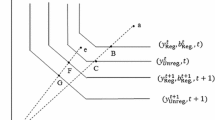Abstract
This paper examines whether firms' decisions about reductions in toxic emissions depend on the magnitude of dangers arising from their pollution and on who bears pollutant risks. Controlling for the quantity of air toxics released in 1988, this article finds that plants whose emissions generated higher numbers of expected cancer cases did reduce their emissions more between 1988 and 1991. The nature of the community bearing the pollution risk also affected firm decisions. The higher the voter turnout in the area, a proxy for residents' likelihood of collective action, the greater the reductions in a plant's release of air carcinogens.
Similar content being viewed by others
References
Arora, Seema, and Timothy N. Cason. (1995). ''An Experiment in Voluntary Environmental Regulation: Participation in EPA's 33r50 Program,'' Journal of Environmental Economics and Management 28(3), 271–286.
Ashford, Nicholas A., James Victor Gobbell, Judith Lachman, Mary Mathiesen, Ann Minzner, and Robert Stone. (1993). The Encouragement of Technological Change for Preventing Chemical Accidents: Moving Firms from Secondary Prevention and Mitigation to Primary Prevention. Cambridge, MA: Center for Technology, Policy and Industrial Development, MIT.
Bartel, Ann P., and Lacy Glenn Thomas. (1985). ''Direct and Indirect Effects of Regulations: A New Look at OSHA's Impact,'' Journal of Law and Economics 28, 1–26.
Brehm, John, and James T. Hamilton. (1996). ''Noncompliance in Environmental Reporting: Are Violators Ignorant, or Evasive, of the Law?'' American Journal of Political Science 40, 444–477.
Coase, Ronald H. (1988). The Firm, the Market and the Law. Chicago: University of Chicago Press.
Coase, Ronald H. (1960). ''The Problem of Social Cost,'' Journal of Law and Economics 3, 1–44.
Cropper, Maureen L., William N. Evans, Stephen J. Berardi, Maria M. Ducla-Soares, and Paul R. Portney. (1992). ''The Determinants of Pesticide Regulation: A Statistical Analysis of EPA Decision Making,'' Journal of Political Economy 100, 175–197.
General Sciences Corporation. (1990). Riskpro: Environmental Pollution Modeling System. Laurel, MD: GSC.
Goldman, Benjamin A. (1994). Not Just Prosperity: Achieving Sustainability with Environmental Justice.Washington, DC: National Wildlife Federation.
Gray, Wayne B., and Carol Adaire Jones. (1991). ''Longitudinal Patterns of Compliance with Occupational Safety and Health Administration Health and Safety Regulations in the Manufacturing Sector,'' The Journal of Human Resources 26, 623–652.
Hahn, Robert W. (1994). ''United States Environmental Policy: Past, Present, and Future,'' Natural Resources Journal 34, 305–348.
Hamilton, James T. (1995a). ''Pollution as News: Media and Stock Market Reactions to the Toxics Release Inventory Data,'' Journal of Environmental Economics and Management 28, 98–113.
Hamilton, James T. (1995b). ''Testing for Environmental Racism: Prejudice, Profits, Political Power?,'' Journal of Policy Analysis and Management 14, 107–132.
Hamilton, James T. (1993). ''Politics and Social Costs: Estimating the Impact of Collective Action on Hazardous Waste Facilities,'' RAND Journal of Economics 24, 101–125.
Harford, Jon D. (1978). ''Firm Behavior Under Imperfectly Enforceable Pollution Standards and Taxes,'' Journal of Environmental Economics and Management 5, 26–43.
Helland, Eric (1998).''The Enforcement of Pollution Control Laws: Inspections, Violations, and Self-Reporting,'' Review of Economics and Statistics 80, 141–153.
Kahn, Matthew E., and John G. Matsusaka. (1997). ''Demand for Environmental Goods: Evidence from Voting Patterns on California Initiatives,'' Journal of Law and Economics 40, 137–173.
Konar, Shameek, and Mark A. Cohen. (1997). ''Information as Regulation: The Effect of Community Right to Know Laws on Toxic Emissions,'' Journal of Environmental Economics and Management 32, 109–24.
Lavelle, Marianne (1993). ''Environment Vise: Law, Compliance,'' The National Law Journal, August 30, S1-S9.
Lewis, Tracy R. (1996). ''Protecting the Environment When Costs and Benefits Are Privately Known,'' RAND Journal of Economics 27, 819–847.
Magat, Wesley A., and W. Kip Viscusi. (1990). ''Effectiveness of the EPA's Regulatory Enforcement: The Case of Industrial Effluent Standards,'' Journal of Law and Economics 23, 331–360.
McCubbins, Mathew D., and Thomas Schwartz. (1984). ''Congressional Oversight Overlooked: Police Patrols versus Fire Alarms,'' American Journal of Political Science 28, 165–179.
Olson, Mary (1996). ''Substitution in Regulatory Agencies: FDA Enforcement Alternatives,'' Journal of Law, Economics, and Organization 12, 376–407.
Orum, Paul (1994). ''Reports Using Toxics Release Inventory TRI Data,'' Working Notes on Community Right-To-Know July-August, 1–11.
Orum, Paul, and Alair MacLean. (1992). Progress Report: Community Right-to-Know. Washington, DC: Working Group on Community Right-to-Know.
Poje, G. V., and D. M. Horowitz. (1990). Phantom Reductions: Tracking Toxic Trends. Washington, DC: National Wildlife Federation.
Portney, Paul R. (1981). ''Housing Prices, Health Effects, and Valuing Reductions in Risk of Death,'' Journal of Environmental Economics and Management 8, 72–78.
Prewitt, Edward, and Richard H. K. Vietor. (1992). Allied-Signal: Managing the Hazardous Waste Liability Risk. Boston: Harvard Business School.
Ringleb, Al H., and Steven N. Wiggins. (1990). ''Liability and Large-Scale, Long-Term Hazards,'' Journal of Political Economy 98, 574–595.
Scholz, John T., and Wayne B. Gray. (1990).''OSHA Enforcement and Workplace Injuries: A Behavioral Approach to Risk Assessment,'' Journal of Risk and Uncertainty 3, 283–305.
Spence, David B. (1997). ''Administrative Law and Agency Policy-Making: Rethinking the Positive Theory of Political Control,'' Yale Journal on Regulation 14, 407–450.
U.S. EPA. (1995). 1993 Toxics Release Inventory Public Data Release. Washington, DC: Office of Pollution Prevention and Toxics.
U.S. EPA. (1994). 1992 Toxics Release Inventory Public Data Release. Washington, DC: Office of Pollution Prevention and Toxics.
U.S. EPA. (1993). Toxics Release Inventory TRI Data Use Conference. Washington, DC: Office of Pollution Prevention and Toxics.
Van Houtven, George L., and Maureen L. Cropper. (1993). When Is a Life Too Costly to Save? The Evidence from Environmental Regulations. Washington, DC: Resources for the Future.
Viscusi, W. Kip. (1986). ''The Impact of Occupational Safety and Health Regulations, 1973–1983,'' RAND Journal of Economics 17(4), 567–80.
Viscusi, W. Kip, and James T. Hamilton. (1999). ''Are Risk Regulators Rational? Evidence from Hazardous Waste Cleanup Decisions.'' American Economic Review forthcoming.
Williamson, Oliver E. (1979). ''Transaction-Cost Economics: The Governance of Contractual Relations,'' Journal of Law and Economics 22, 233–261.
Author information
Authors and Affiliations
Rights and permissions
About this article
Cite this article
Hamilton, J.T. Exercising Property Rights to Pollute: Do Cancer Risks and Politics Affect Plant Emission Reductions?. Journal of Risk and Uncertainty 18, 105–124 (1999). https://doi.org/10.1023/A:1007877728961
Issue Date:
DOI: https://doi.org/10.1023/A:1007877728961




